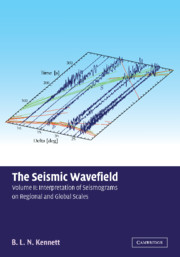Book contents
- Frontmatter
- Contents
- Preface to Volume II
- Part III Local and Regional Events
- 17 Near Events
- 18 Propagation Effects at Near Distances
- 19 Regional Phases I - Propagation in the Crust and Uppermost Mantle
- 20 Regional Phases II - The Influence of Structure
- 21 Propagation in the Upper Mantle
- 22 Upper Mantle Structure
- 23 Analysis of Regional and Far-Regional Seismograms
- Part IV Global Wave Propagation
- Part V The Three-dimensional Earth
- Appendix Paths and Travel times
- Bibliography
- Index
17 - Near Events
from Part III - Local and Regional Events
Published online by Cambridge University Press: 31 August 2019
- Frontmatter
- Contents
- Preface to Volume II
- Part III Local and Regional Events
- 17 Near Events
- 18 Propagation Effects at Near Distances
- 19 Regional Phases I - Propagation in the Crust and Uppermost Mantle
- 20 Regional Phases II - The Influence of Structure
- 21 Propagation in the Upper Mantle
- 22 Upper Mantle Structure
- 23 Analysis of Regional and Far-Regional Seismograms
- Part IV Global Wave Propagation
- Part V The Three-dimensional Earth
- Appendix Paths and Travel times
- Bibliography
- Index
Summary
ground is large and there is a strong interaction with man-made structures. The first instrument specifically designed to record strong ground motion close to an earthquake was installed in Tokyo at the end of the nineteenth century (Sekiya & Omori, 1894). This instrument was built to withstand severe shaking and employed mechanical recording with no amplification. The record displayed by Sekiya & Omori, for an event that caused some damage in Tokyo, was recorded with 3 separate orthogonal components on a circular plate. The largest amplitude of motion is about 45 mm on the NE/SW component with a period close to 2 s for the main pulse but also a long duration of coda. The large amplitudes and extended shaking reflect the influence of the Kanto sedimentary basin on which Tokyo is built.
Strong ground motion recording has been developed in a variety of ways since these pioneering studies, and now many classes of structures have their own instrumentation, notably on dams. In urban areas, recordings are commonly made with accelerometers which are triggered by movement of their surroundings (e.g. in buildings); in the past, this has often meant that only the S waves have been well recorded. The advent of digital recordings means that the new generation of strong ground motion recorders have sufficient memory that the P wave motion can be preserved for stations out to 100–200 km from the event. The emplacement of many such recorders in buildings, which is important for engineering seismology, means that the ground motion is modulated by the interaction with the man-made structure.
Nature of the local wavefield
For larger events where the area of faulting is comparable to the distance of stations fromthe fault, the details of the source process have a strong influence on the nature of the ground motion. The rupture of a major fault occurs progressively and is modified by the presence of stronger portions of the fault. Such ‘asperities’ often serve as nuclei for the distribution of aftershocks.
The nature of the local conditions can also have a profound influence on the recordings of ground motion, both through amplification and reverberation in soft surface sediment but also through interaction with 3-D structure in the vicinity of the fault.
- Type
- Chapter
- Information
- The Seismic WavefieldVolume II: Interpretation of Seismograms on Regional and Global Scales, pp. 3 - 27Publisher: Cambridge University PressPrint publication year: 2002



